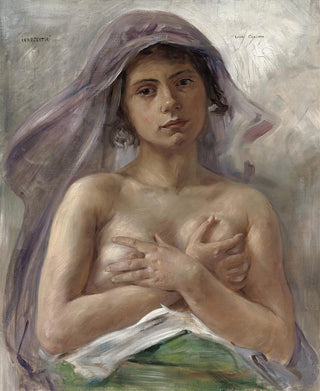Art print | Innocence - Lovis Corinth


View from behind

Frame (optional)
Lovis Corinth's "Innocence" artwork embodies a poetic and delicate vision of childhood, where light plays a crucial role in visual storytelling. This canvas, imbued with softness and serenity, invites viewers to immerse themselves in a universe where innocence and purity are magnified. Corinth, with his mastery of colors and textures, manages to capture the very essence of youth, transforming a fleeting moment into a pictorial eternity. The art print Innocence - Lovis Corinth, although faithful to the original, offers a new perspective on this piece, allowing everyone to appreciate the timeless beauty it exudes.
Style and uniqueness of the work
Lovis Corinth's style is distinguished by a bold fusion of impressionism and post-impressionism, creating a unique atmosphere that characterizes his works. In "Innocence," dynamic brushstrokes and vibrant hues combine to bring the characters to life, while the blurred background evokes a dreamlike sensation. The faces of the children, bathed in soft light, seem almost ethereal, reinforcing the idea of lost innocence. This stylistic approach, which favors emotion over realistic representation, makes Corinth a pioneer in exploring human psychology through art. The composition, both harmonious and daring, demonstrates technical expertise that transcends the simple frame of painting to touch on the universal.
The artist and his influence
Lovis Corinth, born in 1858 in Tapiau in Prussia, is an emblematic figure of early 20th-century German art. His career, marked by travels to France and encounters with major artists, allowed him to evolve within a vibrant artistic environment. Corinth was able to absorb the movements of his time while developing a personal voice that is uniquely his own. His work is not only a reflection of his era but also a source of inspiration for future generations of artists. By exploring themes such as the human condition, sensuality, and nature, Corinth laid the foundations for a new approach to painting, influencing

Matte finish

View from behind

Frame (optional)
Lovis Corinth's "Innocence" artwork embodies a poetic and delicate vision of childhood, where light plays a crucial role in visual storytelling. This canvas, imbued with softness and serenity, invites viewers to immerse themselves in a universe where innocence and purity are magnified. Corinth, with his mastery of colors and textures, manages to capture the very essence of youth, transforming a fleeting moment into a pictorial eternity. The art print Innocence - Lovis Corinth, although faithful to the original, offers a new perspective on this piece, allowing everyone to appreciate the timeless beauty it exudes.
Style and uniqueness of the work
Lovis Corinth's style is distinguished by a bold fusion of impressionism and post-impressionism, creating a unique atmosphere that characterizes his works. In "Innocence," dynamic brushstrokes and vibrant hues combine to bring the characters to life, while the blurred background evokes a dreamlike sensation. The faces of the children, bathed in soft light, seem almost ethereal, reinforcing the idea of lost innocence. This stylistic approach, which favors emotion over realistic representation, makes Corinth a pioneer in exploring human psychology through art. The composition, both harmonious and daring, demonstrates technical expertise that transcends the simple frame of painting to touch on the universal.
The artist and his influence
Lovis Corinth, born in 1858 in Tapiau in Prussia, is an emblematic figure of early 20th-century German art. His career, marked by travels to France and encounters with major artists, allowed him to evolve within a vibrant artistic environment. Corinth was able to absorb the movements of his time while developing a personal voice that is uniquely his own. His work is not only a reflection of his era but also a source of inspiration for future generations of artists. By exploring themes such as the human condition, sensuality, and nature, Corinth laid the foundations for a new approach to painting, influencing






